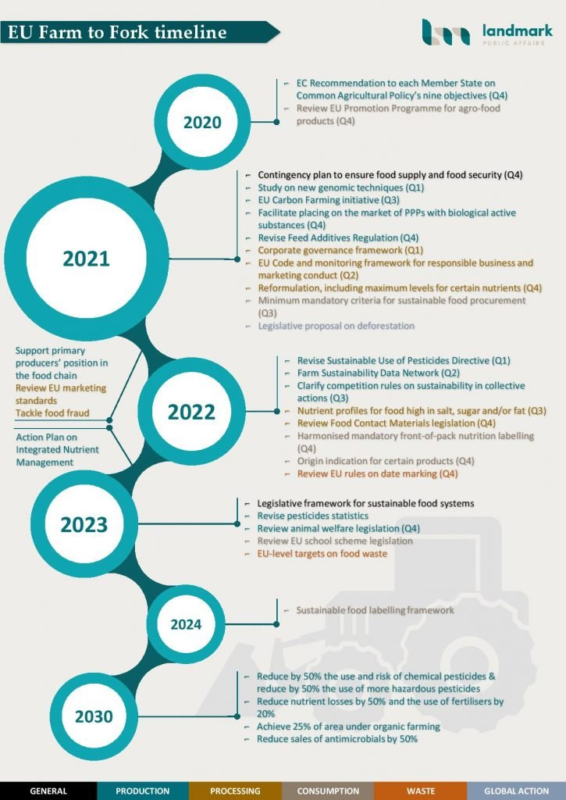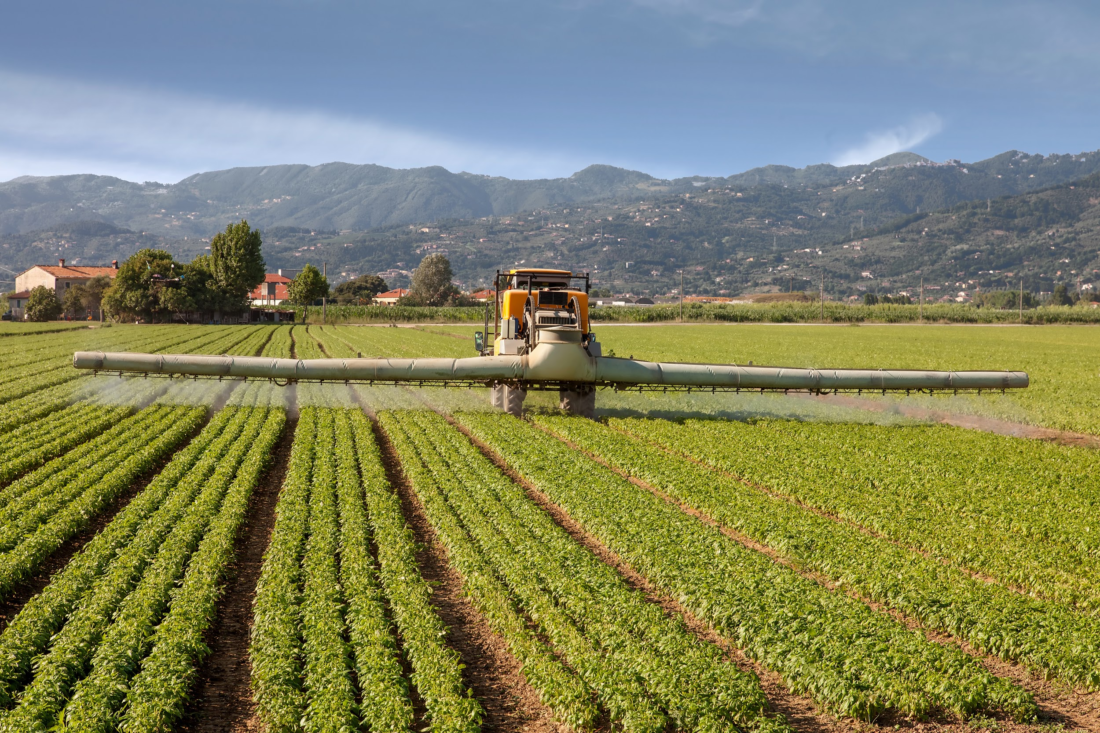EGD: ensuring sustainable food from Farm to Fork
Food is the basis of human existence and important for many cultural and social reasons. But our food production and dietary habits also cause environmental destruction and jeopardise human health. The EU has a plan to change this, but is it good enough?
Our food system – how we produce, process, transport, sell, trade, eat and waste food – puts natural resources under significant pressure. Agricultural practices and the over-production of livestock drive soil degradation and losses, over-abstraction of fresh water, air and water (1, 2) pollution and conversion of important ecosystems (grasslands, wetlands and old-growth forest) to arable land or pasture (1, 2), both within the EU and abroad. Food systems are also the source of 21-37% of all human greenhouse gas emissions and a leading driver of biodiversity loss. In addition, an estimated 20% of food produced in the EU is wasted along the supply chain.
A new wind for food policy
Recognising these problems, on 20th May this year, the Commission published ‘A Farm to Fork Strategy for a fair, healthy and environmentally-friendly food system’. Presented as a ‘cornerstone’ of its political programme, the European Green Deal, the strategy lays out how the European Commission intends to promote a transition towards sustainable food systems. The strategy is closely tied to and was presented together with the updated Biodiversity strategy.

Commission Executive Vice President Timmermans, Commissioner Kyriakides and Commissioner Sinkevĉius on 20 May when presenting the F2F and Biodiversity strategies (source: @SKyriakidesEU on Twitter)
The Farm to Fork (F2F) Strategy generally recognises the issues listed above, and boldly states that it will ensure that food supply chains in the EU have “a neutral or positive environmental impact, preserving and restoring the land, freshwater and sea-based resources on which the food system depends, helping to mitigate climate change and adapting to its impacts, protecting land, soil, water, air, plant and animal health and welfare and reversing the loss of biodiversity.”
Yet, conservatives and farm and industry representatives found the ambitions too far-reaching and unrealistic. For example: the European People’s Party (a centre-right political group in the European Parliament), Copa-Cogeca (representing farmer organisations and cooperatives) and Fertilizers Europe (representing the major mineral fertiliser manufacturers in the EU). Agriculture Ministers have shown very little love for the strategy. So let’s look into the details of this controversial strategy.
What’s behind the cover?
The F2F Strategy is a Commission ‘communication’, i.e. a non-binding document outlining the Commission’s policy priorities. It describes the Commission’s analysis of the unsustainability of the food system and their proposals for how to address it. It is accompanied by a 27-point action plan, with an indicative timeline for some of the commitments made in the communication.
Most of the debate around the strategy has focused on four concrete targets to be achieved in the farming sector by 2030:
- 50% reduction of the overall use and risk of chemical pesticides;
- 50% reduction of nutrient losses, with a corresponding 20% reduction in the use of fertilisers;
- 50% reduction of overall EU sales of antimicrobials for farmed animals and aquaculture;
- and 25% of farmland in the EU to be under organic farming;
As well as a fifth target included in the Biodiversity Strategy:
- 10% of agricultural area under high-diversity landscape features.

While civil society welcomed these targets, uncertainties around baselines and methodologies could make or break their transformative potential. Additional F2F initiatives of interest include:
- A legislative framework for sustainable food systems. 2023;
- Revision of the Sustainable Use of Pesticides Directive. First quarter, 2022;
- EU-level targets for food waste reduction. 2023;
- Revision of the Farm Accountancy Data Network Regulation into a Farm Sustainability Data Network. (2022)
- EU carbon farming initiative. (2021)
- Development of minimum mandatory criteria for sustainable food procurement. (2021)
- Development of an Integrated Nutrient Management Action Plan (announced in the Circular Economy Action Plan)
One step forward, but three steps too short
Since it was announced in July 2019, the EEB has been very supportive of the Commission’s European Green Deal. We also welcomed the F2F Strategy and recognised the leadership provided by the Commission by publishing this ambitious vision in the midst of a global pandemic. Yet, we also noted three major shortcomings of the Strategy, which we continue to press the Commission to act on.
First, it is regrettable that the Strategy does not set a clear direction for EU agriculture towards agroecology, as demanded by the EEB and large parts of EU civil society. In many parts, the Strategy talks of the need for system change but promises techno-fixes. In addition, the Strategy’s diagnosis of the resilience of our food system in the light of Covid-19 fails to recognise structural weaknesses of EU agriculture such as chronic overproduction in the livestock sector or dependence on migrant labour in the fruit and veg sectors due to overspecialisation. As a consequence, no actions are proposed to enhance the resilience of EU agriculture through a restructuring of the farming sector towards agroecology, diversified farming, and shorter food supply chains, despite strong calls from civil society to do so.
Second, despite recognising the unsustainability of current livestock production and consumption, action on this front is lacking. A clear commitment to “accompany the transformation to sustainable livestock systems” through the CAP which was included in a leaked version of the Strategy just days before its publication, disappeared in the final version. Consequently, the strategy does nothing to initiate the much-needed transition to ‘less and better’ livestock production and meat, dairy and eggs consumption.
Last but certainly not least, the Commission relies primarily, if not solely, on the CAP to deliver the F2F targets, despite 3,600 researchers, the European Court of Auditors, think tanks and civil society unanimously warning that the proposed new CAP is not fit for purpose. Even the Commission itself, in an analysis published alongside the F2F Strategy, while stressing the “potential” of the CAP to deliver on the EU Green Deal, also explicitly recognised several “potential obstacles and/or gaps jeopardising the ambition level of the Green Deal in the agricultural sector”. For this reason, Client Earth and the EEB have called on the Commission to revise its CAP proposal, to avoid being in breach of the EU Treaties and greenwashing the CAP.

What’s more, since these are EU-level targets, intense political struggles can be expected over how much different member states should contribute to the overall targets, depending on starting point and national conditions. In the face of staunch resistance from industry and several national Governments, agricultural Commissioner Wojciechowski recently told the French senate that the targets might need to be revised if they threaten food security and agricultural competitiveness. In sum, it remains to be seen if these targets lead to much real change.
Scouting for cues in the horizon
With no sign of the Commission taking action on the failing CAP reform, the European Parliament’s plenary vote on the CAP in October will be crucial. The success of the Farm to Fork Strategy and wider EU Green Deal objectives such as climate-neutrality are in MEPs’ hands. For the new CAP to deliver anything on the environment or climate, despite reluctant national Agriculture Ministeries, the EU Green Deal targets must be integrated in the law, the climate and environmental dimensions must be strengthened, and the performance framework tightened.
The ongoing negotiations in the Council are decisive too, and here, the importance of the German presidency in setting the tone for the final sprint of the CAP reform process can hardly be overstated.
The EEB and several other civil society organisations are pushing tirelessly for the Parliament to respond to citizens’ demands for climate action and nature protection by voting for a much more ambitious CAP reform. To show how better, sustainable EU food systems could look, we are regularly publishing articles about our vision for ‘Future farming’ based on the principles of agroecology.
Verdict?
The F2F strategy, in combination with the new Biodiversity strategy, is a big and important step towards food system sustainability in the EU, and one that would have seemed unimaginable just a year ago. It is important to recognise that it is a milestone in EU policy, but not forget that the publication of the strategy in itself has not solved anything. The commitments made are bold but maybe not enough to slow down the destruction of nature and depletion of natural resources caused by our food system. And most importantly, nothing will change until these promises are turned into reality through strong laws and policies and effective implementation and enforcement.
For the F2F strategy to truly mark a paradigm shift and a new trajectory towards more sustainable food systems in the EU and abroad, citizens, civil society, researchers, and other stakeholders must continuously remind decision makers of our support and expectations. The transition must be profound and we will need everyone to be onboard.
Asger Mindegaard is policy and project assistant for agriculture, and Celia Nyssens, policy officer for agriculture at the European Environmental Bureau (EEB).
Autor*in:
Asger Mindegaard und Celia Nyssens






